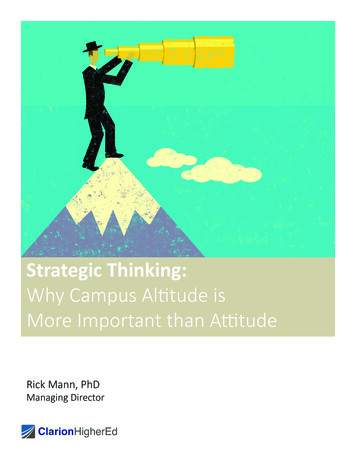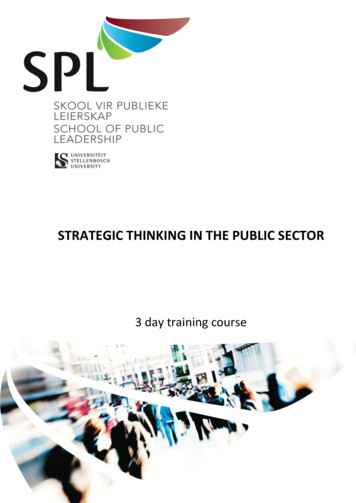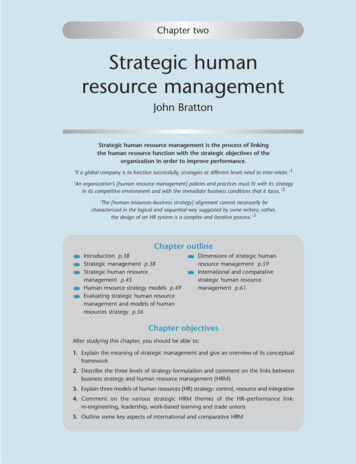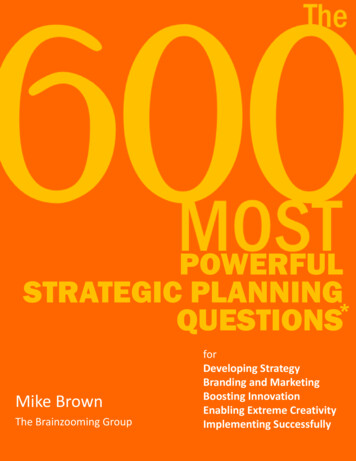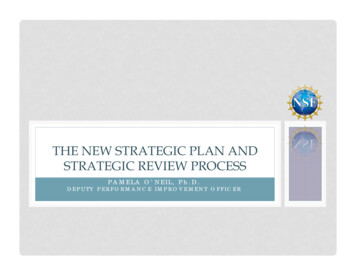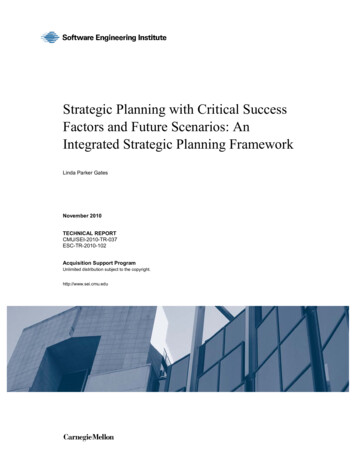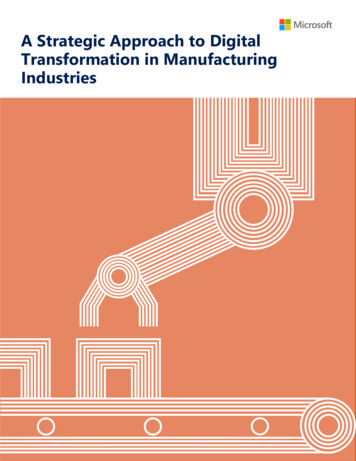
Transcription
A Strategic Approach to DigitalTransformation in ManufacturingIndustries
Executive SummaryDigital transformation holds the potential to transform everymanufacturing operation. Process transformation means convertingtraditional processes to more efficient digital systems that can increaseefficiency dramatically, improving all aspects of the operations. Productand service transformation means creating new value-add services thatcan both improve the manufacturing environment and the customerexperience while opening new revenue streams.Before embarking on a digital transformation journey, it’s critical tounderstand your objectives, adopt a holistic yet realistic approach, andpartner with the right advisor who can support you on both thetechnology and strategy aspects of your initiative.i
ContentsExecutive Summary . iDefining your path to digital transformation . 2Build a vision for your transformation journey . 3Gaining efficiency through process transformation . 3Creating new opportunities with product and service transformation . 5Develop a holistic and realistic strategy . 7Align strategy and technology . 7Take an agile approach . 7Ensure relevance to your vertical . 7Identify the right collaborative partner with industry expertise . 8Microsoft understands the unique challenges of the manufacturing industry and verticals in the digital age. . 9Learn more.111
Defining your path todigital transformationDigital technology has played a vital role in the manufacturing industry for years.Compared to other industries, manufacturers are ahead of the curve when itcomes to incorporating digital technology into business processes. Todaythough, digital is no longer simply a tactical aspect of the manufacturing business– it’s becoming vital to pursue end-to-end digital transformation in order toachieve objectives like improving efficiency and quality, reducing costs and waste,and creating innovative products and services.Digital transformation is about applying technologies to radically changetraditional processes, products and services into data-driven, highly connectedsolutions that can be monetized through extreme efficiency gains and entirelynew business models. With a digital-first approach, firms are accelerating timeto-market, providing new customer value through digital experiences, managingcomplex global value chains and innovating to dramatically improve thecustomer experience and create new revenue opportunity. In short, the promiseof digital transformation is just that – transformational.But driving digital change is easier said than done. While the benefits that digitaltransformation offers are tremendous, there is no single, one-size-fits allapproach. Each firm’s journey is unique. As a result, finding an approach that fitsyour business is critical. There are also a number of pitfalls to avoid. Well-craftedstrategies can easily fail to be fully realized unless they are supported in the rightways, resulting in lost investment, lost time and an erosion of organizationalsupport.To set your firm on a course that makes sense for your business, it helps toconsider three foundational guidelines. Regardless of your specific businesssituation, using these guidelines during the early planning stages will strengthenyour overall outcomes and increase the likelihood of a successful initiative.1. Build a vision for your digital transformation journey2. Develop a holistic and realistic strategy3. Identify the right collaborative partner with the industry expertiserequired to deliver the change you needThe first of these is building a f digital transformation initiative vision toundertake and your priorities in bringing about these changes. Some firms needto make process changes. Others are ready to start pursuing new digital-enabledrevenue opportunies immediately. Second is understanding how key aspects ofyour approach can make a big difference in your results. These include howbusiness and technology strategy relate, and how prioritizing agility contributesto better outcomes. Finally, selecting a partner who can collaborate with you andremain engaged throughout your digital transformation journey is key. The bestlaid plans can easily go awry without knowledgeable execution or partners whounderstand the intricacies and best practices of your industry. In subsequentsections, we’ll explore in more depth what each of these guidelines mean.2Digital Transformation in Manufacturing
Build a vision foryour transformationjourneyThere are two types of digital transformation: Process transformation: digitizing existing processes andprocedures to improve efficiency and operations. Product and service transformation: developing newdigital services and experiences for customers that improvesatisfaction and loyalty and that create new sources ofrevenue.Getting clear on the type of transformation you are going tofocus on (or identifying that both types make sense, given yourobjectives) is an important starting point. Each has the potentialto dramatically improve your trajectory of future growth andperformance.Gaining efficiency through process transformationthyssenkrupp wanted to better monitorand service their 1.1 million elevatorsinstalled around the globe. Being in someof the most famous buildings in theworld, lack of insight and unpredictedfailures led to costly downtime. Byconnecting thousands of sensors in theirelevators to the Microsoft cloud,thyssenkrupp gained real-time visibilityinto product performance and rapid,remote diagnostic capabilities. Today,thyssenkrupp has reduced maintenancecosts and elevator downtime by armingtheir 20,000 elevator service technicianswith the ability to visualize and identifyproblems ahead of a job. Techniciansalso have remote, hands-free access toexpert technical information when onsite.As thyssenkrupp has experienced,process transformation can deliverdramatic operational improvements.3Process transformation is critical for companies with legacy paper-basedsystems or digital systems. Without a modern digital information backbone,there are inevitably inefficiencies, such as manual processes, siloed data, andduplicative efforts. This results in limited access to information foremployees, hindering their productivity. Entrenched practices andprocedures may also be sources of inefficiency, necessitating retraining.It’s useful to think about process-related digital efforts in stages. First,converting and optimizing general operational processes to digitalworkflows can deliver immediate results, such as unifying email, calendar,messaging, voice and collaboration. This type of streamlining is highlyvaluable, as it makes a major difference in how efficiently an organizationfunctions. Giving employees more access to actionable information enablesthem to do their jobs more effectively. From there, more advancedworkflows can be developed, such as analytics-driven decision support anddigital field service processes.These new digital capabilities give employees better, more timelyinformation, directly supporting objectives like higher first-time fix rates. Thelong-term benefits of process change can be wide-ranging. For instance,advanced analytics paired with remote device monitoring can analyze a widerange of systems and predict when maintenance will be needed before acomponent fails and causes disruption. Another benefit is better allocationof human resources, like field service engineers. Digital workflows canensure that the optimal resource is assigned to the highest-priority activities.Insights from digital workflows pave the way for reduction in time andwaste, as well as improvements in quality and production efficiency.Digital Transformation in Manufacturing
Rockwell Automation wanted to differentiateitself from competitors. Using Microsofttechnologies to monitor their expensive, remoteequipment, Rockwell now offers proactive, datadriven advice to customers. With full visibilityinto equipment performance, it’s easy to alertcustomers to potential issues and give themprecise insights into how to address them. In anindustry where a single pump failure in anoffshore rig can cost a company 300,000 a dayin lost production, these insights are ofsignificant value to Rockwell’s customers. Afterpartnering with Microsoft, Rockwell significantlyreduced customers’ troubleshooting efforts andhas made the design manual consult a thing ofthe past.4Process transformation can rapidly make a major difference. In 2014,the 14,000-employee company Kennametal transformedcommunication and collaboration between locations in 60 countries byproviding employees seamless videoconferencing, instant messagingand document collaboration capabilities between locations. By givingemployees 24/7 access to company news, business intelligence anddigital collaboration, it reduced barriers between employees workingfar apart and created the next best experience to working together inperson.Digital isn’t just about adding a new level of reliability and speed toexisting systems and processes – though it does deliver that. It alsomeans gaining more accurate, real-time information about theperformance of your business. Robotics manufacturer KUKA is a goodexample of how process transformation can unleash hidden potential.Engineers obtained unprecedented insight on the performance of anassembly line by connecting 60,000 devices and robots to theMicrosoft cloud and running advanced analytics. Using these analyticalresults to predict machine failure before it occurs, KUKA engineersnow minimize both planned and unplanned downtime by knowingwhen machines need to actually be serviced – and the best time totake them offline to minimize disruption.Digital Transformation in Manufacturing
Creating new opportunities withproduct and service transformationProduct and service transformation is about usingdigital technologies to deliver innovative servicesand experiences, which translate into new revenuepotential. This often involves the computerization ofentire product platforms and the monetization ofdata-driven services.In some cases, manufacturers have been offeringthese types of services for a while but without thespeed, agility and analytic capabilities offered bytoday’s cloud based technologies. Aircraft enginemanufacturer Rolls-Royce, for instance, has beenusing data models for years to determine whenaircraft engines require maintenance. Grounding anaircraft for maintenance is incredibly costly for anairline, so being able to schedule it precisely was amajor improvement over previous methods. NowRolls-Royce can analyze larger data sets whichincreases the accuracy of predictive maintenancerecommendations and respond quickly to customerdemands for new business or operational insights.Beyond jet engines, products of all kinds arebecoming increasingly computerized, or “smart.”Smart products are built with a computing platformthat makes them dynamic. For instance, a washingmachine might download a new power efficiencyprogram to reduce water or power use and thecustomer’s bills – and similar kinds of featureenhancements could be delivered over the lifetimeof the product therefore retaining its value.5Digital Transformation in Manufacturing
Rolls Royce has adopted improveddigital systems that allow engineers tonot only schedule engine downtime,but predict the specific repair actionsthat need to be taken and the partsthey need. If an engine needs a newfuel pump urgently, for instance, thatinformation is instantly available tomaintenance crews, who can have theexact parts ready to go before theequipment fails. With hundreds of livespotentially on the line in the event of acatastrophic equipment failure, thebenefits of having this information arehuge. Airlines using Rolls Royceengines can be confident their enginesare constantly being monitored forproblems before they occur. For RollsRoyce, this not only builds customerconfidence and loyalty but is also ahigh-margin business.Adding digital components to products not only makes it possible to updatethem over time – it also enables new service delivery and improves thecustomer experience. For example, a smart heating furnace automaticallyidentifies when it needs service and proactively prompts its owner to schedule aservice date and time. A smart refrigerator can identify when a household needsmore milk, or something is about to expire, and sends a text message alert – orautomatically re-orders it. A smart power generator set can examine historicaldata to know when demand will be lower and reduce its fuel consumptionautomatically. The smart power generation solution can also offer other adviceaimed at reducing costs, emissions and maintenance needs. These are just afew examples of the new scenarios that product and service transformationsupports – the possibilities are broad.Smart products can also transform the manufacturing environment itself,building on process transformation that has already been accomplished. Anindustrial robot assembling pickup trucks, for instance, might needmaintenance ahead of schedule and notifies the plant’s engineeringdepartment accordingly. Catastrophic failure is avoided, and downtime isminimized. This technology can help in the supply chain as well. Rigs on theroad can be tracked in real time and re-routed automatically to avoid badweather, for instance, heading off a supply shortage that could lead to massiverevenue losses.Perhaps most importantly, products with smart components and a digitalplatform enable organizations to turn their knowledge and insights into aservice that can be monetized. This approach provides an avenue for addingvalue on an ongoing basis, and is a natural enabler of ongoing customerrelationships rather than traditional transactional-based customer engagement.Whether your plans include process transformation, product and service transformation, or both, understanding the scopeof your initiative is essential. Equally important are the choices you make around strategy, technology and projectapproach, which we’ll cover in the next section.6Digital Transformation in Manufacturing
Develop a holistic andrealistic strategyDigital transformation can’t happen in absence of a wider strategy that reflects your businessobjectives matched with technology. As your strategy is developed, there are three keyconsiderations that are easy to overlook, but important to evaluate: The relationship between strategy and technology How prioritizing agility contributes to longer-term success The unique requirements for your industry and verticalAlign strategy and technologyTaking a holistic approach to business and technology from the outset is critical, as it makesa major positive difference in the timeline, cost and outcomes of a digital transformationeffort. In contrast, pursuing a strategy independent of technology considerations invitesunnecessary risk. When a firm goes down the path of developing a strategy without realizingthe full potential of technology, it’s all too common to find that there is a gap. For example, astrategy may seem promising, but may ultimately not be fully realized. When this happens, adigital transformation initiative must be rescoped, which means wasted time and investment.An integrated approach that incorporates both strategy and technology greatly reduces thisrisk.Take an agile approachAgility is another critical success factor, since an agile, incremental approach ultimately helpsfirms realize more value from digital transformation efforts. Too often, when consultants arebrought in to lead transformation, the result is an unwieldy project that fails to get tractiondue to its massive scope.Instead, it is more effective to develop an overall strategy at a portfolio level, and then breakit down into individual projects. This enables a focused initial scope that can be expandedover time. Ultimately, the success or failure of digital transformation depends on howtechnology and process changes function under real-world conditions. That’s why it’s criticalto focus an initial project on a proof of concept (POC) to support rapid learning anditeration.Using a POC to prove, refine or refactor objectives is an agile foundational method thatmakes it possible to achieve results in a shorter timeframe and build a roadmap forward. Italso provides the opportunity to improve or enhance the plan as needed to create long-termchange.Ensure relevance to your verticalA strategy that reflect your industry vertical is essential. Not all verticals have the same needswhen it comes to digital transformation. The aerospace industry has specific challenges andopportunities, some of which, but not all, are shared by other verticals. It’s important to beable to draw upon expertise that’s specific to your vertical to ensure you’re taking advantageof all possible opportunities offered by digital transformation. A vertical-oriented approachcan even be the difference between transformation and a stalled project.No matter which form of digital transformation you’re pursuing, the odds of a successfulinitiative increase when you think holistically about business and technology strategy, takean agile approach and apply a vertical-specific lens.7Digital Transformation in Manufacturing
Identify the right collaborativepartner with industry expertiseGiven the challenges and the risks inherent in a paradigm-altering shift like digital transformation, it’s important to avoidgoing it alone. Transformation efforts grounded in industry and vertical expertise are more likely to fit your individualcircumstances and result in better, more relevant solutions. Whoever you choose to help should have an intimateknowledge of your objectives and scope, a deep understanding of the technology being used and a strong base ofexperience helping others with digital transformation initiatives.It’s also important to choose a partner that can help you think through the entire digital transformation journey while alsoassisting with the full execution of that vision. Partners should be extremely familiar with the underlying technologyinvolved with the transformation. They should be able to offer deep knowledge of the specific vertical because mostpartners try to approach these projects with only general knowledge of the manufacturing industry, not specific expertise.This is important because it ensures that all the thinking in the planning phase is carried out without the scope creep thatcan work its way into this type of project. Planning and setting up a proof of concept is an important step, but ultimatelythe success or failure of digital transformation depends on getting to the broad rollout stage.It’s also critical to make sure the technology you’re using doesn’t change the overall strategy or adversely influence theobjectives you’re pursuing. Long-term strategy should come first and technology should support your goals, not the otherway around. Having the right experts on hand who can guide your digital transformation approach helps ensure thesuccess and viability of your strategic plans.8Digital Transformation in Manufacturing
The Microsoft differenceMicrosoft understands the unique challengesof the manufacturing industry and verticals inthe digital age.Working with Microsoft ensures that your digitaltransformation initiatives will be grounded in carefulconsideration of the guiding principles we’ve just outlined.Microsoft Services works with you as a collaborative partnerto deliver on your specific, unique objectives. Our teams aretrained to understand the goal, identify risks and walk withyour company through each step of transformation. Webring unique expertise that can only come from thecompany that designs and builds the tools that organizationuse every day. That’s because we have access to the expertswho actually develop the products you’re deploying. We’veled the way in enterprise technology for decades and we’reapplying that background, combined with industryknowledge and expertise, to help unlock new opportunitiesvia digital transformation.9Digital Transformation in Manufacturing
Transform with help from Microsoft expertsMicrosoft team members have deep experience in both the manufacturing industry and in specific verticals, embodyingthe ideal of vertical integration between strategy and the technology that delivers change. They’re not just consultantsworking from a script, but have often worked in the industries they are working with and understand them to the core.This expertise influences every aspect of the advice Microsoft team members give our customers. Having depth in theindustry means the advice our teams give is grounded in industry realities. Our teams of industry experts take a strategicview of the change you want to achieve, help you translate that into actionable plans, and participate in the executionprocess.By partnering with you, Microsoft helps you drive transformative change while minimizing risk. We believe in a unifiedapproach to digital transformation, one that involves both business and technology considerations and one thatmaximizes agility and flexibility. That means keeping an eye on how digital transformation actually impacts your corebusiness. We can help you scope both the process and external changes you may need to make, and find the rightprocesses to transform now versus later. We also provide on-the-ground expertise to ensure that your initiative issuccessful.Digital transformation needs to deliver results that matter and help you achieve wider business goals. By choosingMicrosoft, you’re also helping improve the next generation of those products and ensure that they meet the changingneeds of your business. We look forward to helping you unlock the opportunities that digital transformationpresents.10Digital Transformation in Manufacturing
Learn moreMicrosoft Services and osoftservices/industry/manufacturing.aspxMicrosoft and Discrete us/industries/discrete-manufacturing/Microsoft and Process 11Digital Transformation in Manufacturing
Microsoft Services empowers organizationsto accelerate the value imagined and realizedfrom their digital om/servicesmicrosoft.com/sportsolutions 2017Microsoft. All rights reserved.
Digital transformation is about applying technologies to radically change traditional processes, products and services into data-driven, highly connected solutions that can be monetized through extreme efficiency gains and entirely new business models. Wi


